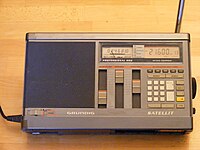
Photo from wikipedia
Achieving high-resolution time-to-digital conversion is challenging at high count rates. In past work, the highest resolutions with low dead times (≤2 cycles) on field-programmable gate arrays (FPGAs) have been achieved… Click to show full abstract
Achieving high-resolution time-to-digital conversion is challenging at high count rates. In past work, the highest resolutions with low dead times (≤2 cycles) on field-programmable gate arrays (FPGAs) have been achieved using digital signal processing (DSP) blocks or using the wave-union method. In this article, we investigate the possibility of combining the wave-union method with DSP blocks. With the given configuration on a Xilinx Artix-7 200T FPGA, we achieve 13.60-ps single-shot precision (SSP) using only 3.78% of the FPGA fabric per channel (1.22% of the fabric in the finite step response (FSR) injector and 2.56% of the fabric in the delay line) for three edges, compared to 52.65 ps using 2.97% of the FPGA fabric per channel without the wave-union method. The scaling of edge numbers (for higher resolutions) is shown to be significantly better than the previously suggested parallel implementation, at just 0.407% of the FPGA fabric per edge compared to ~2.5% per edge in the parallel implementation. Temperature characterization showed an SSP penalty of just 4 ps over a 60 °C temperature difference.
Journal Title: IEEE Transactions on Instrumentation and Measurement
Year Published: 2022
Link to full text (if available)
Share on Social Media: Sign Up to like & get
recommendations!